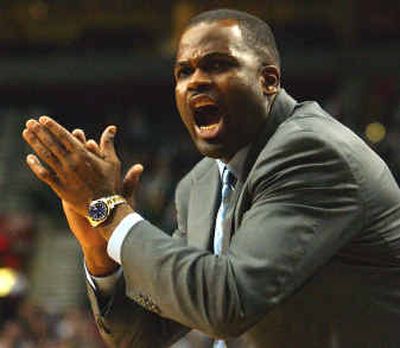Sonics fit McMillan’s style

This is what Seattle coach Nate McMillan wanted all along. He has his guards creating pressure and forcing turnovers. He has his players moving the ball and using their shooting ability to devastate opponents with pick-and-rolls. He has a backcourt that moves faster than the beer vendors working the courtside seats – that wasn’t quite the case with 34-year-old Gary Payton at point guard two years ago and natural shooting guard Brent Barry playing the point after Payton was traded.
McMillan has what he has wanted during his four-plus mostly bland years as Seattle’s coach. Barry left for San Antonio as a free agent last summer, and McMillan admits that even if the SuperSonics had kept Barry, he planned to make second-year point guard Luke Ridnour a starter this season.
“Pressure defense, pushing the ball … Gary and Brent were not able to do that at that point of their careers,” McMillan says. “We wound up being a team that didn’t really have an identity. Last year, I felt like I wasn’t really being myself. This is how I wanted to play.”
The Sonics have responded. They have run, pressured and shot their way to a 17-4 start, averaging 99.9 points per game and leading the league in 3-point shooting at 38.7 percent. They have deflated the notion that the fast start was a fluke by knocking off San Antonio and Dallas on consecutive nights – in Texas.
Credit McMillan as the engineer of this turnaround, which has been incredible for a team that loafed through the preseason at 2-6 and lost to the Clippers by 30 points on opening night. McMillan’s future seemed tenuous then, especially because the Sonics had declined to extend his contract. With eight players on the roster heading for free-agent status next summer, the Sonics seemed destined for me-first play, and McMillan seemed to be coaching for his job.
“I never saw it like that,” McMillan said. “I never thought of this as a do-or-die year for me. Everybody talks about the hot seat, but my seat wasn’t any hotter than usual.”
McMillan always has been a friend to players – he became a head coach just two years after retiring and is only 40. In the final year of their contracts, many coaches get walked on. McMillan, however, got tough.
“For me, it was just a matter of, ‘Get it done. Get it done, or go to the bench; it’s that simple.’ Doesn’t matter who you are,” McMillan said.
McMillan has been helped by roster changes. Ray Allen (23.8 points per game) and Rashard Lewis (21.0) still are the top offensive options, but Danny Fortson has added a roughhouse element to the team’s inside game, and Nick Collison provides added rebounding. The Sonics swiped Fortson from Dallas for Calvin Booth last summer and added Collison after he missed all of his rookie season recovering from surgeries on both shoulders.
“The thing about playing this style is that we’re able to play 10 or 11 guys,” McMillan says. “When everyone is getting time like that, it raises them up a little. So we have 11 guys playing above average right now.”
How long it will last is unknown.
Boston has shown the Sonics can be had by turning their own style against them – play small, pressure the perimeter shooters and run.
But the real mystery in Seattle is beyond this season. Allen is scheduled to become a free agent next summer, but the Sonics are unlikely to give him a maximum-dollar contract.
Front-court starters Jerome James and Reggie Evans will be free agents, as will top bench men Antonio Daniels and Vladimir Radmanovic.
The Sonics have managed to play as a team, though.